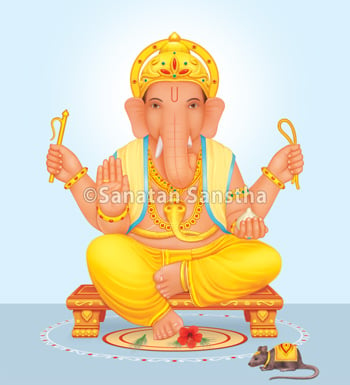
Origin and meaning
Gana (गण) + pati (पति) = Ganapati. As per the Sanskrut language, Gana means a ‘pavitrak’. A pavitrak is the subtle most particle of Chaitanya (Divine consciousness). ‘Pati’ is Master. Hence, ‘Ganapati’ is the Master of pavitraks.
Some other Names of Shri Ganapati and their meanings
Sage Mudgal has written the Ganeshasahastranam containing the thousand Names of Shri Ganapati. The Dwadashanam shloka (Verse) contains the following twelve Names of Shri Ganapati –
Vakratunda, Ekadanta, Krushnapingaksha, Gajavaktra, Lambodar, Vikata, Vighnarajendra, Dhumravarna, Bhalachandra, Vinayak, Ganapati and Gajanan.
The meanings of these twelve Names and those of some others are given ahead.
1. Vakratunda
Generally, Vakratunda means one with a curved, crooked mouth or trunk; however, this is incorrect. According to the Sanskrut saying ‘वक्रान्तुण्डयतिइतिवक्रतुण्डः।’, meaning ‘Vakratunda, is one who punishes those following a crooked (meaning, unrighteous) path and thereby brings them onto the straight (meaning, righteous) path.’ Vakratunda, therefore is the one who straightens the tiryak and visphutit, meaning, the crooked Raja-Tama predominant 360 waves through the medium of His trunk and makes them straight, sattvik (Sattva-predominant) like the 108 waves.
2. Ekadanta or Ekashrunga
Shri Ganapati bears this Name because He has only ek (one) unbroken danta (tusk). Of the two tusks, the right tusk is intact, while the left one is broken.
A. The right side represents the suryanadi (Sun channel). As the suryanadi is radiant, the tusk on this side can never be broken.
B. Ekadanta is symbolic of the one and only Brahman (God Principle).
C. The word ‘dantin’ (दंतीन) is derived from the root ‘dru-darshayati’ (दृ-दर्शयति) (meaning, to show). Thus Ekadanta also means, ‘He who shows the direction that provides the spiritual experience of one and only Brahman.’
D. Medha and shraddha (Faith) are the two tusks. ‘Medha’ means intellect, the ability to comprehend. Medha is the incomplete (broken) tusk and shraddha is the complete tusk.
3. Krushnapingaksha
This word is derived from Krushna (कृष्ण) + pinga (पिंग) + aksha (अक्ष). ‘Krushna’ means dark complexion, ‘pinga’ means smoky and ‘aksha’ means the eye. The dark complexion is in the context of earth while the word smoky refers to the clouds. Thus, Krushnapingaksha is ‘He who has the earth and the clouds as His eyes, meaning, He who can see everything from the earth to the ether.
4. Gajavaktra
A. ‘Gaja’ means cloud and is considered to be the representative of the dyu (द्यु) region – the region of the Deities. ‘Vaktra’ means mouth. Thus, one whose mouth is the dyu region is Gajavaktra and He is enormous ! If placed vertically, we can experience Gajavadan (or Ganapati).
B. Mudgalpurana explains the meaning of the word ‘Gaja’ as ga = the Principle wherein everything undergoes Dissolution, and ja = the Principle from which everything originates. Hence, ‘Gaja’ means Brahman (God Principle).
5. Lambodar
The word ‘Lambodar’ is formed from ‘lamba’ (Large) and ‘udar’ (Belly).
Saint Eknath has explained the meaning of this word as – ‘The entire animate and inanimate creation dwells within you. Hence, you are called Lambodar’. – Shri Eknathi Bhagwat 1.3
According to the Ganapatitantra, Deity Shiva played the damaru (A small hourglass shaped drum). Shri Ganapati grasped the knowledge of the Vedas through the deep sound of the damaru. He learnt dancing by watching the Tandavnrutya (Cosmic dance) of Shiva every day. He learnt music from the sound of the anklets of Parvati. He imbibed, meaning, digested such varied knowledge; hence, His belly is large.
6. Vikat
Vi (वि) + krut (कृत) + akat (अकत). ‘Vi’ means in a specific manner, ‘krut’ means done and ‘akat’ means Moksha (Final Liberation). Hence, ‘Vikat’ means He who generates waves in a specific manner and bestows Moksha.
7. Vighnesh
Vighna (विघ्न) + Isha (ईश) = Vighnesh (विघ्नेश). The word ‘vighna’ is derived from the Sanskrut term ‘Visheshenghanati’ (especially the distress). The Isha (God) of obstacles, distress, meaning, He who controls and destroys obstacles is Vighnesh. The obstacle in this context refers to getting surrounded by the 360 (Raja-Tama component) and 108 (Sattva component) waves. This is against a devotee’s aim of becoming trigunatit (Going beyond the three components). The word Isha (ईश) is a combination of I (ई) + sha (श). I (ई) denotes ikshate (इक्षते), meaning, to watch and sha (श) denotes shamayate (शमयते), meaning, to cool down. Thus, Isha is one who keeps a watch on and destroys the heat generated by the 360 and 108 waves. Vighnaharta (Vanquisher of obstacles) is another Name of Shri Ganapati. Since Shri Ganapati gets rid of obstacles, He is worshipped before performing any auspicious religious ceremony.
8. Dhumravarna
‘Dhumra’ means smoke and ‘varna’ means complexion. Smoke is the transitory state between sagun and the nirgun. He who possesses such a smoky complexion is known as Dhumravarna. According to the principle of ‘where there is smoke, there is fire’, Shri Ganapati possesses the Tejtattva (Absolute Fire Principle).
9. Bhalachandra
‘Bhala’ means the forehead. The waves arising from Prajapati, Brahma, Shiva, Vishnu and Meenakshi unify, and from them many groups comprising of thousands of waves are generated. Though Prajapati, Brahma, Shiva, Vishnu and Meenakshi are all nirgun, their waves have components. From these, the point of origin of three of these waves, namely – affection, mercy and motherly love is referred to as the Chandra (Moon). He who adorns such a Chandra on the forehead is Bhalachandra. Actually this is the Name of Deity Shankar. But since Shri Ganapati is His son, He, too, acquired this Name !
10. Vinayak
According to Sanskrut, the word ‘Vinayak’ is derived from ‘Vishesharupen nayakaha’. It means, He who is endowed with all the features of nayak (Leader). It is universally accepted that there are six Vinayaks. The summary of information on Vinayakgana (Attendants of Vinayak) given in the Manavgruhyasutra and Boudhayangruhyasutra is that the Vinayakgana create obstacles and are troublesome and cruel. When they start harassing, people begin to behave as if insane. They get nightmares and are constantly under some fear. To overcome these obstacles posed by the Vinayakgana, the scriptures have advocated various rituals known as Shantividhi. Shri Ganapati is Vinayak, meaning, the Master of these Vinayakganas. Once, Deity Shiva blessed Shri Ganapati that the Vinayakgana would be His servitors and He would be worshipped first in various rituals like Yadnyas (Sacrificial fires) etc. Those failing to do so would face obstacles in their rituals. From then on, worship of Shri Ganapati at the beginning of an auspicious ceremony came into existence. The Vinayakgana were obstacles personified; but Vinayak became the eliminator of obstacles. He became Siddhivinayak, that is, bestower of abhishta (Desired) siddhis (Spiritual powers).
11. Shri Ganapati
Please see ‘Point Origin and meaning’ above.
To Read more about Shri Ganapati Click here
12. Gajanan
‘Gaja’ means elephant and ‘anan’ means countenance (or face). Thus, Gajanan is He whose countenance is like that of an elephant (and whose body constitutes the entire universe).
13. Vratapati
‘In the stotra (hymn) Shri Ganapatyatharvashirsha, Shri Ganapati is offered salutation as ‘Namovratapataye.’
14. Chintamani
‘Chintamani is another Name of Shri Ganapati. Kshipta (Insane), mudha (Stupid), vikshipta (Whimsical), ekagra (Closely attentive) and niruddha (Having restraint) are the five attributes displayed by the subconscious mind. He who enlightens on these attributes, is Chintamani. According to Mudgalpuran, Devotion unto Chintamani destroys the five attributes of the subconscious mind and complete Shanti is attained.
15. Mangalmurti
‘Mang’ means complete, or in entirety, and ‘glugayate’ (in Sanskrut) means He who bestows peace or purity. That which purifies both internally and externally is mangal (Auspicious).
An idol that endows auspiciousness is ‘Mangalamurti’. In Maharashtra, the phrase ‘Mangalamurti Moraya’ is used to proclaim Shri Ganapati’s glory. The word ‘Moraya’ is taken from the name of a famous devotee of Shri Ganapati in the 14th century, Moraya Gosavi from Chinchwad, near Pune in Maharashtra. Thus, this proclamation depicts the inseparable bond between God and His devotee.
The following spiritual experience will illustrate how inseparable a bond Moraya Gosavi had with Shri Ganapati.
Automatically switching over to the chant of Shri Ganapati instead of the Family Deity while drawing the picture of Moraya Gosavi
‘When I began drawing the picture of Moraya Gosavi, I was chanting the Name of my Kuladevata (Family Deity), Devi Renukamata; but when the picture was complete, I realised I was chanting ‘Shri Ganeshaya Namaha’. – Ms. Madhura Bhosale,Goa
(One principle in Spirituality is that ‘Word, touch, form, taste, fragrance and their energies coexist’. Since Ms. Madhura Bhosale was completely engrossed in drawing the picture of Moraya Gosavi (a fractional Incarnation of Shri Ganapati), she automatically and unwittingly started chanting ‘Shri Ganeshaya Namaha’, meaning, the words were linked with the form. – H.H. Dr. Athavale)
16. Umaphal
‘Uma’ is Devi Parvati and ‘phal’ means product. Shri Ganapati acquires this Name since He is the product, meaning, the son of Devi Parvati. ‘Umaphal’ also means spiritual knowledge. Shri Ganapati is the Deity of spiritual knowledge. The Name ‘Umaphal’ befits Him, either ways.
17. Vidyapati
Shri Ganapati is the Master of the 18 vidyas (Knowledge) – 1. Shiksha (Science of proper articulation and pronunciation), 2. Kalpa (A part of the Vedas that explain the rituals), 3. Vyakaran (Grammar), 4. Nirukta [Etymological explanation of difficult Vedic (Pertaining to Vedas) words], 5. Jyotisha (Astrology), 6. Chhanda (Science of prosody), 7. Rugveda, 8. Yajurveda, 9. Samaveda, 10. Atharvaveda, 11. Purva-uttarmimansa (Concerned with the correct interpretation of Vedic rituals and the settlement of doubts with regard to Vedic texts), 12. Nyaya (System of Hindu philosophy founded by Sage Gautam), 13. Puranas, 14. Dharmashastra (Science of Righteousness), 15. Ayurveda, 16. Dhanurveda, 17. Gandharvaveda and 18. Nitishastra (Science of ethics). Hence, before commencing the study of any of these or in the ritual performed for their study, ritualistic worship of Shri Ganapati is important.
18. Brahmanaspati
The Vedas are referred to as Brahman. They may also be termed as Vedabrahman. Shri Ganapati is the Master of the mantras in these Vedas. Hence, He is known as Brahmanaspati.
Different Names according to regions
We find that Shri Ganapati is known by different Names in different regions. In Tamil Nadu Shri Ganapati is called as ‘Pillaiyar’, in Nepal He is known as ‘Suryaganapati’, in Myanmar (formerly Burma) as ‘Mahapini’, in Mongolia as ‘Dhotkar’, in Tibet as ‘Ekadanta’, in Cambodia as ‘Pradganesh’, in the Java islands as ‘Kalantaka’, in China as ‘Kvanshitiyik’, while in Japan He is known as ‘Vinayakasha’.

 Maghi Shri Ganesh Jayanti 2025
Maghi Shri Ganesh Jayanti 2025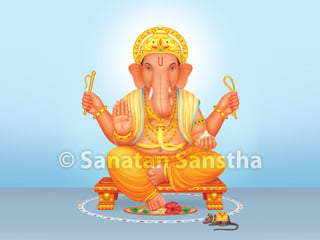 Sankashtnashan Stotra
Sankashtnashan Stotra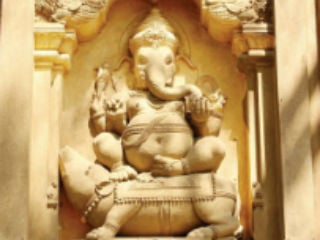 Signs of ancient Hindu culture left behind in foreign lands
Signs of ancient Hindu culture left behind in foreign lands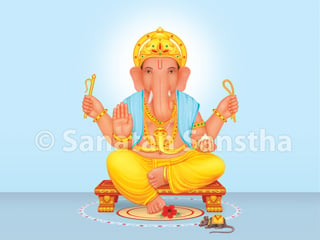 Some mantras to be recited when worshipping Shri Ganesh with specific objectives
Some mantras to be recited when worshipping Shri Ganesh with specific objectives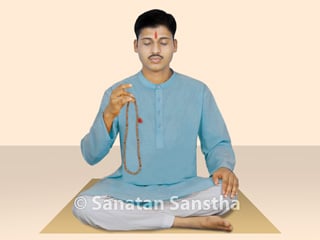 Chants of Shri Ganesh
Chants of Shri Ganesh